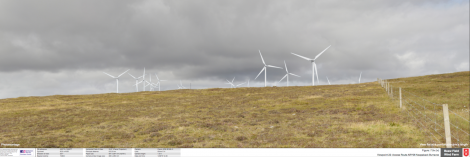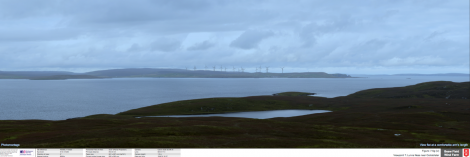News / Oil industry airport objects to wind farm
THE operator of the oil industry airport at Scatsta has objected to a proposed wind farm development in the nearby island of Yell on the grounds of aircraft safety and potential operational impacts.
Serco says the Beaw Field wind farm, which would have 17 145-metre high turbines, could be visible on Scatsta’s radar since they are to be built beneath the airport’s main inbound and outbound route.
Scatsta airport handles between 14,000 and 20,000 aircraft movements per year, both fixed wing planes and helicopters, and is one of the main employers in the north of Shetland.
The company’s objection is supported by oil company BP, the operator of the nearby Sullom Voe Terminal, which is licensed by the Civil Aviation Authority to use Scatsta Airport.
However, Manchester-based wind farm developer Peel Energy has rejected the airport’s concern and commissioned a counter report by chartered engineer Mike Watson of Pager Power Ltd. The company has been undertaking wind farm aeronautical and radar impact assessments since 2002.
In his report, Watson said there was no reason to refuse the planning application on aviation grounds because the development “falls entirely outside the safeguarded area shown on the airport’s own safeguarding map”.
Earlier this year Peel Energy lodged a Section 36 application to the Energy Consents Unit, in Glasgow, to build the 70MW wind farm at the south end of Yell, around eight miles to the northeast of Scatsta Airport.
The proposed development – ultimately dependent on an interconnector being built to link Shetland to the national power grid – is widely supported by the Yell community.
In Scatsta’s letter of objection, airport manager John Thorne said the aerodrome was strategically located adjacent to both the Sullom Voe Terminal and newly-built Shetland Gas Plant and played a “vital role” in the UK government’s drive to maximise oil and gas recovery.
Become a member of Shetland News
As such Serco was concerned that the development could have an adverse impact on the airport’s operability.
“The development is located in close proximity to Scatsta airport in a key area of airspace beneath the main inbound approach and outbound route to and from Scatsta airport,” he wrote.
“In its proposed location, the development may have a significant impact on the final approach track and climb out, requiring amendment to the instrument flight procedures (IFP).
“Serco is concerned that 17 turbines with a maximum height of 145 metres would be visible to Scatsta airport radar and generate unwanted returns (clutter) on air traffic control display screens with the potential to mask aircraft in the vicinity of the development.
“Serco is specifically concerned that the development may adversely affect communication with fixed wing and rotary aircraft travelling on this flight path.”
But Watson said the need to implement changes to the airport’s instrument flight procedures has long been acknowledged and work to implement these was already under way.
He said: “I have considered the main concerns raised in Serco’s objection letter and have not identified and valid reason for refusing this application.
“There will be a requirement for mitigation and it would be prudent to ensure, perhaps using a planning condition, that mitigation is implemented prior to erection of the wind turbines in the event that planning permission is granted.”
Anti-Viking campaign group Sustainable Shetland has also objected to the Yell proposal voicing concern over the “cumulative effect” of large wind farm developments in Shetland – quoting a recent Scottish government policy paper that envisaged 900MW of onshore wind farms in Shetland by 2030.
Scottish Natural Heritage and the RSPB have, meanwhile, put forward proposals to mitigate the possible impact of individual turbines on the breeding population of red-throated divers and merlin.
Shetland Islands Council’s planning committee is likely to discuss the wind farm proposal at its meeting on 27 September.
The committee is a statutory consultee and is required to make a recommendation to the Energy Consents Unit.
Become a member of Shetland News
Shetland News is asking its many readers to consider paying for membership to get additional features and services: -
- Remove non-local ads;
- Bookmark posts to read later;
- Exclusive curated weekly newsletter;
- Hide membership messages;
- Comments open for discussion.
If you appreciate what we do and feel strongly about impartial local journalism, then please become a member of Shetland News by either making a single payment, or setting up a monthly, quarterly or yearly subscription.





























































